Oliver Ressler – Gathering around the Wreckage
Texte
Humanity is on the brink of global ecological catastrophe. Copernicus Climate Change Service data show global temperature in 2016 close to 1.5°C above pre-industrial levels.1 Many scientists regard this threshold as the “red line” beyond which global warming will rampage beyond hope of control.
Human survival is at stake, yet public outcry for immediate action remains strangely muted, at least within official politics and media.
My work has focused on global warming as a central theme ever since I first began to exhibit. One of my first solo exhibitions was 100 Years of Greenhouse Effect at Salzburger Kunstverein (1996). The title refers to the text On the Influence of Carbonic Acid in the Air upon the Temperature of the Ground, published by the Swedish scientist Svante Arrhenius in 1896.2 In this text Arrhenius informed the scientific community that, according to his calculations, the average global temperature would rise over the long term as a result of the carbon dioxide produced by humans (through combustion processes). This work by Arrhenius opened a discontinuous and ongoing debate on the greenhouse effect. The date of its publication also stands out as an indictment of governments’ reckless reluctance to acknowledge a global threat and the inadequacy of their belated and barely serious response.
Meetings held since 1990 under the United Nations framework resulted in December 2015 in the COP21 agreement. This so-called Paris Agreement was applauded by politicians and most media, but it is manifestly weak and dishonest. The words “oil”, “gas” and “fossil fuels”, are missing from the final text, as is “free trade”. COP21 is a non-binding agreement; meanwhile, international trade is regulated at supranational level under binding agreements, whose complex legal machinery is backed by real powers of enforcement. This difference alone is clear evidence of the lack of any serious commitment to the reduction of carbon emissions, even at a time when many politicians publicly recognize the reality of climate change. For all their newfound understanding, there is no sign whatsoever of the many actions required immediately if carbon emissions are to be reduced. It should come as no surprise, then, that CO2 emissions continue rising even after 23 annual UN climate summits. Governments and intergovernmental bodies still do little or nothing to prevent “non-linear climate shift”: the sudden and permanent catastrophe that scientists see coming as global temperature continues to rise.
It would seem that neither politicians, political parties, governments and the UN nor capitalists (“green” or otherwise, whether on conglomerate or “boutique” scale) will save us. It is up to us to fight for the shape of the future.
A new social movement – the climate movement – has formed in response to dominant states’ refusal to cut CO2 emissions or even to take seriously the threat of irreversible ruin. This movement is bigger and more unified than it looks, because spectators see only occasional footage of isolated “newsworthy” interventions, rather than the relentless pressure exerted by activists all over the world. This climate movement has obstructed pipeline projects, stopped Arctic drilling and blocked fracking all over the globe.
An early sign of the strength of the climate movement came in August 2008 in the UK, where a climate camp was organized with the purpose of shutting down the Kingsnorth coal-fired power station east of London. Although Kingsnorth was already slated to be closed, the energy corporation E.ON planned to replace it with a new coal-fired power station on the same site, so as to assure itself of profit over the coming decades. This plan conflicted in every conceivable way with the necessity of reducing CO2 emissions. As an observing participant at the climate camp, I took photos and made audio recordings. There was a general agreement at the climate camp not to permit filming. The resulting work – For a Completely Different Climate (2008), a 3-channel slide installation with sound – combined photos, short texts and audio recordings of the demonstrations and workshops. As a result of the successful protests, Kingsnorth closed permanently in 2012, with demolition starting in October 2014. E.ON abandoned its plans to replace the power station in 2010.
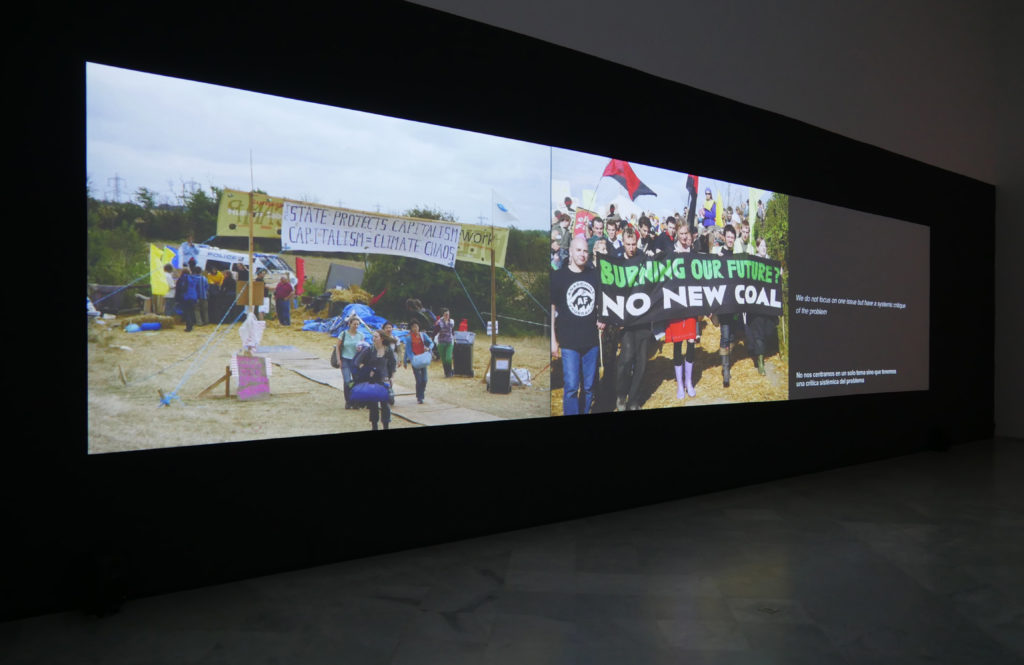
Another important strategy is to force divestment from fossil investments, to pressure institutions to unload stock held in fossil fuel corporations. The idea of fossil divestment is taken up in my billboard series Failed Investments, first shown in public space as part of 7th Grolsch ArtBoom Festival in Krakow in 2015, and subsequently presented in an English-language version in various formats in art exhibitions internationally.
In Poland, deregulated capitalism has had direct effects on the development of cities, the housing people live in and the means of transport carrying those people from their housing to work and back again. In Krakow and other Polish cities, a single-family house seems to be the most favoured living arrangement. This goes hand in hand with the huge cult of individual ownership currently seen in Poland and encouraged by Polish politicians. Right now in Krakow a lot of residential buildings are going up: single-family units, tract housing and condominium apartments often designed as gated communities. Because the city no longer funds public housing, all these homes are built by private investors.
According to the architectural editor Dorota Lesniak-Rychlak3, in Krakow “urban planning by the city government hardly exists. There are several instruments, but they are ineffective. To allow the investor to go wherever land is cheap and to create something out of the blue is also an effect of a lack of planning.”
Suburban sprawl, growth of car-dependent settlements, transformation of “garden cities” into “gated cities” and proliferation of polluting individual heating systems can all be seen as results of inadequate or simply absent urban planning. At a time of peak oil and global warming – crises which could only be counteracted through a planned economic transformation directly contradicting hegemonic neoliberal politics – all these buildings will soon prove to be ecologically unsustainable, and as such, failed investments.
All around Krakow, huge billboards solicit buyers for these new housing units, creating an advertising smog: yet another kind of smog in a region already suffering severely as one of the most polluted parts of Europe.
Failed Investments adds some billboards to those already there, placing criticism of the new private housing developments directly in the midst of the countless advertisements. On the first billboard is a montage of a bursting housing bubble targeted by a dripping filler pipe, with a pipeline crossing a landscape in the background. The second billboard shows a burning suburban house, referring to the vulnerability of housing in the droughts that are ever more frequent under the extreme temperatures caused by global warming.
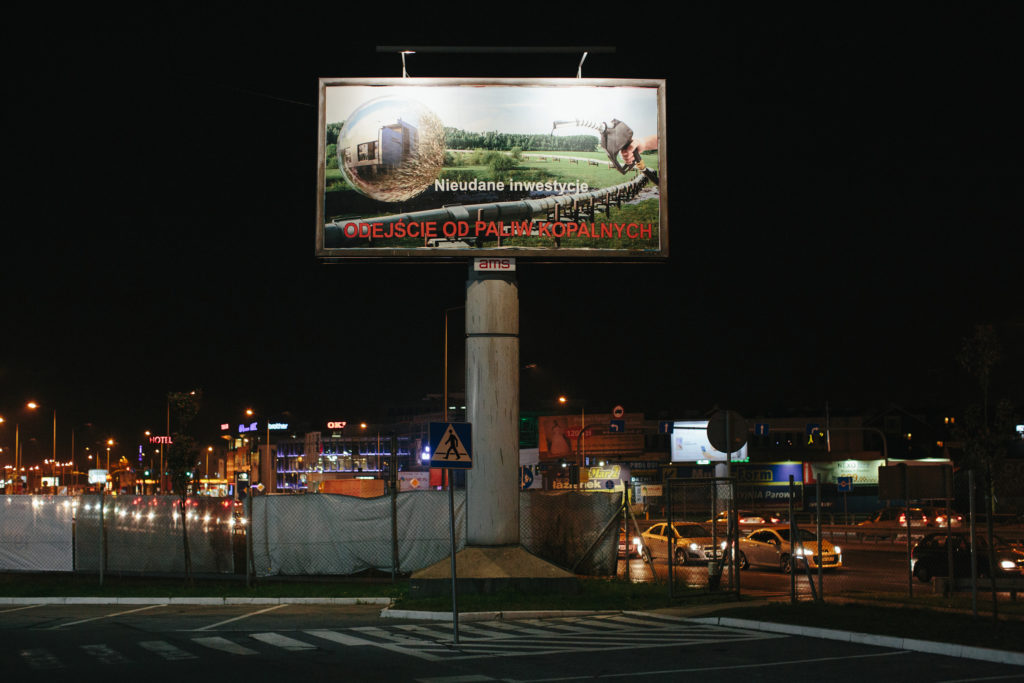
(installation view: 7th Grolsch ArtBoom Festival, Krakow, 2015; photo: Michał Ramus)
Both billboards contain text describing suburban houses as failed investments and advocating a logical first step towards survival, namely fossil divestment.


Another aspect that must be addressed if governments are to take the fight against global heat death seriously is the “free trade” mantra of global capitalism. Two large-scale photographic works titled The economy is wounded – let it die! (2016), intervene in this debate, asserting as a first premise that nothing but systemic economic transformation – including radical curtailment of worldwide trade and shipping – can counteract climate change and associated global threats. This would mean much more production on a regional basis for local consumption, in contrast to the current system that squanders vast amounts of diesel on trans-continental goods transport and concentrates pollution-spewing factories in the global South. Today production in Asia for consumption in Europe is said to emit six times the CO2 that would seep out from the same dirty work done close to the consumers’ European home.4
One of the photographic images comprising The economy is wounded – let it die! was first presented on the façade of the ar/ge kunst in Bolzano (Italy) as part of my solo exhibition Everything Under Control (2016). Exhibited in the middle of a shopping street, the image shows container ships and other vessels sinking at sea, referring to the necessity to disrupt unfree trade. The ships of the old order are literally already sinking. They must be abandoned as fast as possible, along with the whole moribund age of petrocapitalism.
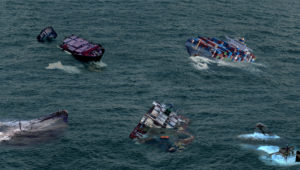
The second photographic image forming part of The economy is wounded – let it die! was presented as a large-format billboard as part of the exhibition ... was haben wir dann heute? (“so, what do we have today?”), curated by Maren Richter at Schallaburg in Austria in 2016. The image shows a panoramic view of the Danube near Melk, the town closest to the billboard’s location. Cargo shipping of the kind seen is common on the Danube, carrying some 10 million tonnes of freight a year into and out of Austria or straight through it. But the ships on the poster are wedged together and some have run aground. Smoke rises and parts of the ships are charred. Diesel spills visibly onto the surface of the water.

At first glance the photographic mise-en-scène suggests a serious shipping disaster, but closer inspection reveals a blockage that could not be accidental. The Danube is seen barricaded from one bank to the other: the cargo channel is cut off and the river made impassable for all shipping, in what could only be a deliberate act of sabotage.
Many social movements now demand the end of the so-called “free movement of goods”. The economy is wounded: let it die! attempts to convey this succinctly in single images. The title alludes to a graffito in Paris, May 1968 (L’économie est blessée, qu’elle crève !). Here this evokes the crisis intrinsic to present-day global capitalism, which can be overcome only through social participation on a massive scale in oppositional praxis of all kinds.
The ongoing film project Everything’s coming together while everything’s falling apart (2016, ongoing) brings together some current examples of much-needed oppositional praxis.
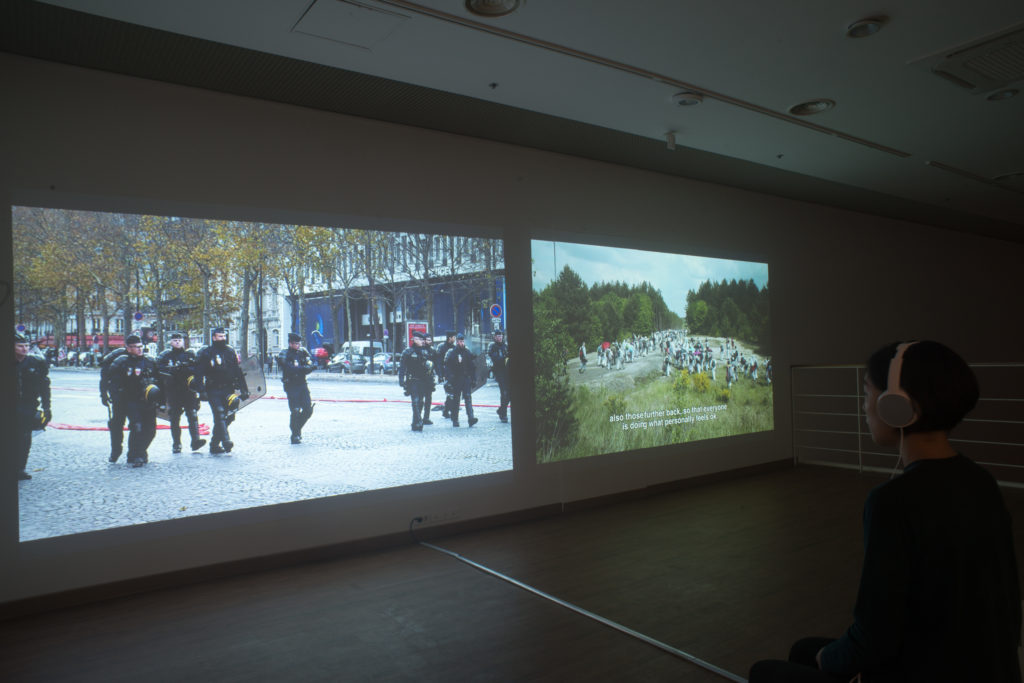
The story of this film project may turn out to be a story of the beginning of the climate revolution, the moment when popular resistance began to reconfigure the world. The project follows the climate movement in its struggles to dismantle an economic system heavily dependent on fossil fuels. It records key events for the climate movement, bringing together many situations, contexts, voices and experiences. There is one film for each event.
In the first film (17 min., 2016), activists contest the UN Climate Change Conference in Paris, a city then under a state of emergency (effectively made permanent by recent French legislation). Like twenty failed annual climate conferences before it, COP21 in Paris in 2015 proved the incapacity of governments to commit themselves to any binding agreement that would curtail global warming through a definite strategy for the end of fossil fuel use. The resulting Climate Agreement avoids anything that would harm the economic interests of corporations.
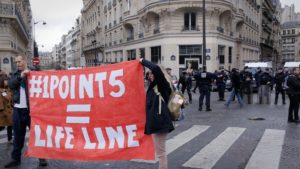
The film on the Ende Gelände (“end of the road”) action (12 min., 2016) shifts the focus to a massive civil disobedience operation at the Lusatia lignite coal fields (near Berlin), in which 4,000 activists entered one of capitalism’s nightmarish landscapes of ruin, an open-cast mine, blocking the loading station and the rail connection to a coal-fired power plant. The blockades disrupted the coal supply and forced the Swedish proprietor Vattenfall to shut the power station down.
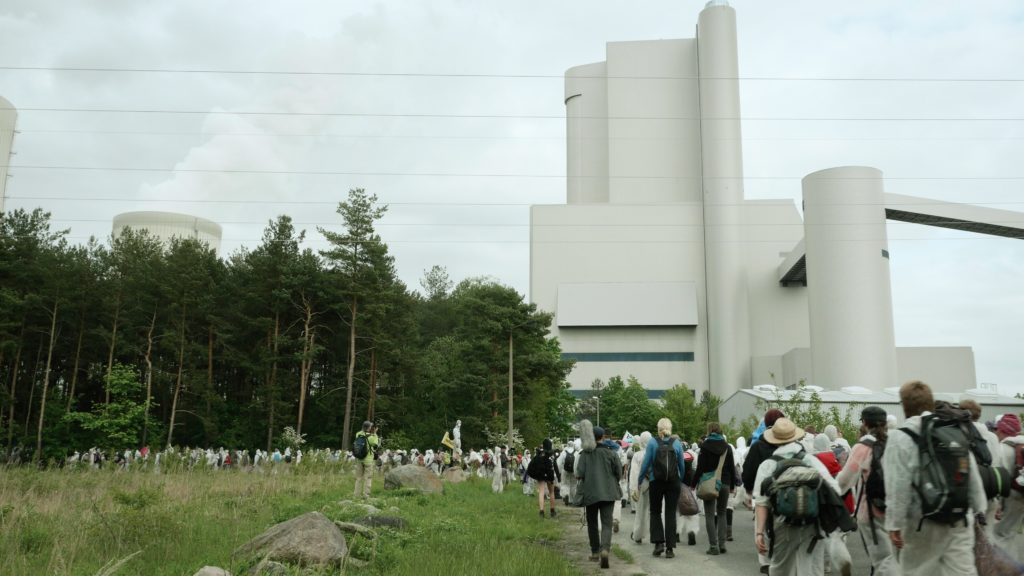
The action was part of an international “global escalation” against the fossil fuel industry, calling on the world to “Break Free from Fossil Fuels” and putting that imperative directly into practice.
The film on the ZAD (36 min., 2017) focuses on Europe’s largest autonomous territory, located close to Nantes in France. The ZAD (zone to defend) emerged from the struggle against a new airport. In 2012 the French state’s attempt to evict the zone was fiercely resisted by more than 40,000 people. The police have not set foot there since. Today 250 people in 60 collectives live permanently at the ZAD, occupying the wetlands, fields and forests. The ZAD is a successful example of the way resistance and the creation of alternatives need to happen at the same time. While people take back control over their lives with self-organized bakeries, workshops, a brewery, medicinal herb gardens, a rap studio, weekly newspaper and a library, they hinder the construction of an unnecessary, ecologically disastrous airport project. The film is built around a group discussion with activists living at the ZAD.
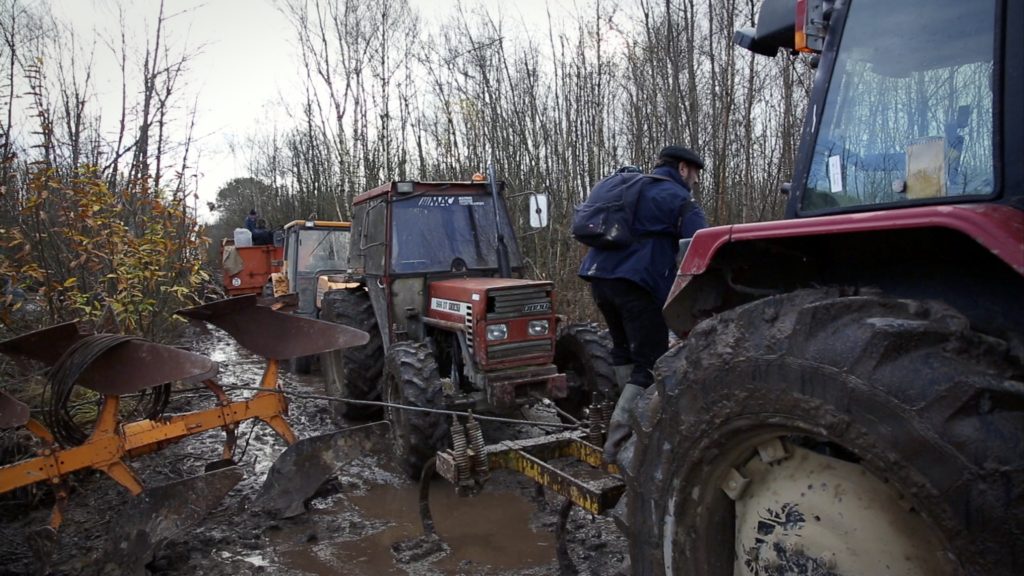
The film Everything’s coming together while everything’s falling apart: Code Rood (14 min., 2018) focuses on a civil disobedience action in the port of Amsterdam in June 2017. The blockade of Europe’s second-largest coal port draws a red line against this important fossil-capitalist infrastructure facility. The largest single source of the coal shipments is Colombia, where coal is extracted under ecologically and socially devastating conditions (“blood coal”).

Despite the efforts of government and corporate PR to convince us otherwise, whether fossil fuels will be abandoned and when this will happen will be decided primarily by social movements and the degree of pressure they exert on institutions. Powerful structures force us into lives that destroy our livelihood. It is these structures that must be changed, and nothing but our action in common can change them.
Everything’s coming together while everything’s falling apart was first presented as a 2-channel video installation as part of my solo exhibition Property is Theft (2016) at MNAC – National Museum of Contemporary Art in Bucharest. This exhibition was also the first time two activist figures from the New Model Army (2016/2017) were seen. Others showed up in The Extractive Machine – Neo-colonialisms and Environmental Resources (2017) at the PAV (Parco Arte Vivente) in Torino, curated by Marco Scotini, acting as a sort of silent entourage. New Model Army breaks the official silence, bringing spectres of the unseen climate movement protagonists into the gallery in the form of life-size mannequins.
One mannequin is dressed as a polar bear – a species whose survival is threatened as the Arctic sea-ice falls away from under its feet. Another is the double of an Ende Gelände activist – one of thousands who shut down Europe’s filthiest coal-fired power plant and thousands everywhere intent on spoiling carbon-fattened business plans. A mannequin all in red stands for a climate movement axiom: “BE THE RED LINE”. If institutions ignore the difference between life and planetary death, only we can make the line impossible to cross. The fourth climate warrior seems poised for self-defence against violent police. Not spoiling for a fight, but unwilling to bow to the riot squad ranks in armed occupation of the streets.
The mannequins stand in for activists whose civil disobedience ensures that no new eco-looting enterprise, however routine it may seem to stockholders, can ever be considered a done deal. These models are not even a perfect template or paradigm: something real but not yet real enough; container of the Geist of something still to come. The mannequins are stand-ins, visible ciphers for the unseen action of the climate movement everywhere. The modified mannequins hold up headline-style slogans concerning the crossing of the 1.5° threshold, e.g. “BLOODY RED LINES: CARBON UNCHAINED” and “400 CARBON PARTICLES – RED LINE CUTS GLOBAL THROAT”.
Rumours suggest that this army will grow over time.
Change will only happen through the relentless increase of political pressure – through uprisings, blockades, boycotts, strikes, anti-mining civil disobedience and divestment. Real systemic change will only be achieved through strong social movements. The various forms of resistance already existing need to connect, and new ones need to flourish. TJ Demos put it this way: “If we are to survive the Anthropocene – which is indeed a big if – what we need urgently is more activism, not neutrality, to rescue the democratic political process from corporate oligarchs, to enact a just transition beyond the fossil fuel economy, to reassert the priorities of equality, and to eliminate discrimination and prejudice.”5
What will never work is any kind of technocratic solution that would putatively reduce carbon emissions while leaving capitalist power relations and inequality untouched.
Now is the time to join the struggle to create a more egalitarian, democratic system from below: one that would not be hostile either to nature or to people. A system that urgently needs to be dragged from the wreckage of petrocapitalism.
Further Information about these and related projects can be found at www.ressler.at
Thanks to Matthew Hyland for critical revision and copy-editing.
Notes
- https://climate.copernicus.eu/news-and-media/press-room/press-releases/earth-edge-record-breaking-2016-was-close-15%C2%B0c-warming
- The text was published in London, Edinburgh and Dublin Philosophical Magazine and Journal of Science.
- In a conversation with Oliver Ressler on 11 March 2015 in Krakow.
- See: Naomi Klein, This Changes Everything: Capitalism vs. the Climate (New York: Simon & Schuster, 2014), p. 79-80
- TJ Demos, Against the Anthropocene – Visual Culture and Environment Today (Berlin: Sternberg Press, 2017), p. 81.
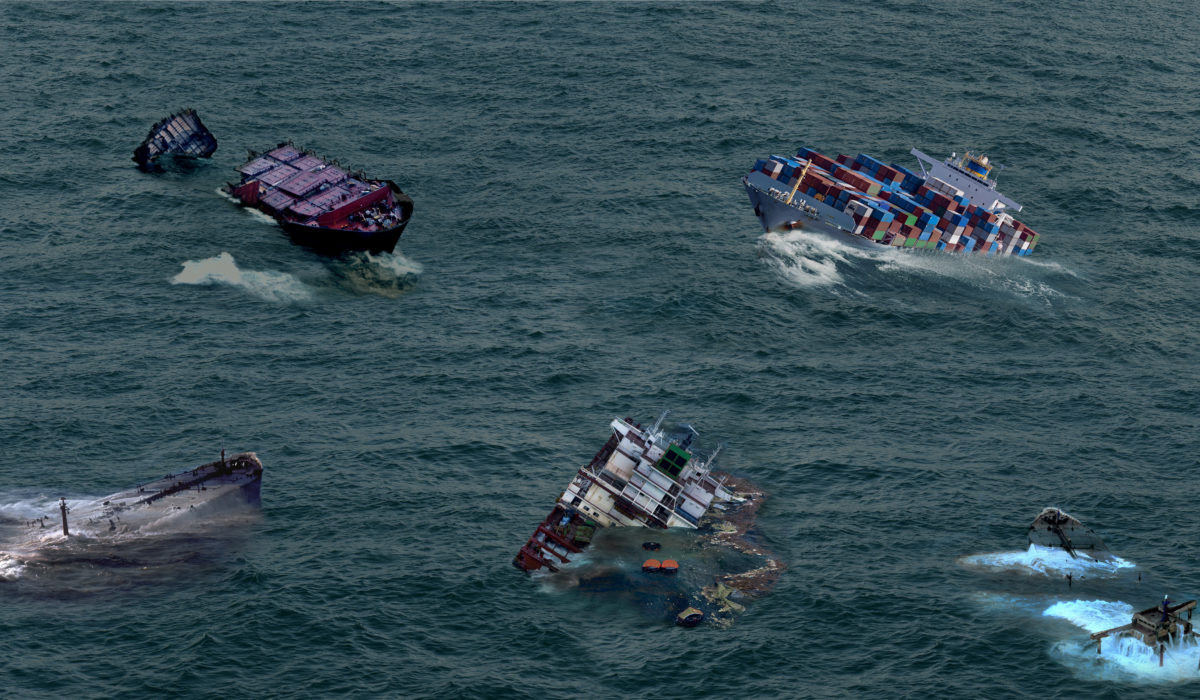
 Retour au sommaire
Retour au sommaire 

